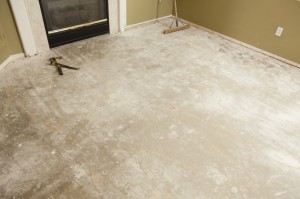Considering changing out the flooring in your home? The style and color of your choices may not be the most important things. Instead, you may want to look past the flooring to your subflooring. 
The subflooring in your home is an important aspect that deserves your attention when you are building or remodeling your home. This surface is what carries the weight of everything in your home; it is an essential part of the structure of your home.
There are typically four primary materials that are used to make a subfloor. The most common materials used to create a subfloor include plywood, plank, Oriented Strain Board and concrete slabs. Most flooring types can be installed over any of these materials. The method of installation and the materials that make up your chosen surface are the main difference.
Plywood and plank boards are both made from southern pine and are the most common materials used because they are inexpensive, yet durable. Sheets of plywood are glued together to form the base for your floor. The edges are tongue and grooved to provide a secure base for the flooring that goes on top of it.
Plank subfloors are made of southern yellow pine boards and are nailed to the joists. This material is typically found in older homes and has a tendency to expand and contract over time. If you are remodeling your home, it is important to secure the boards to ensure that your new flooring is secure and looks the way you desire.
Oriented Strain Board consists of wood chips that are glued together to form a solid base. The installation of OSB ranges from gluing it down to nailing it to the joists and it offers an eco-friendly choice for your surface.
Concrete slabs are also a good subfloor for any type of flooring and is usually around 4-6 inches thick. Make sure that moisture tests are consistently repeated to detect any moisture that could be trapped by your flooring. This could cause severe problems in the future.

For all of your Denver Hardwood Flooring needs visit our site today.